| OTHER ARTICLES |  |
OF THE WORLD GOVERNMENT
| OTHER ARTICLES |  |
Military organisation is a complex subject and one that very few fans and creators of Robotech works have a grasp of. Military organisational terms are bandied about in the TV series, novels, comics, web-sites, etc. with little concern for what they should actually mean and how they relate to each other. Even a little of the vast amount of uninformed discussion in Robotech Internet fora is enough to drive any student of military science to despair.
Analysis of military organisation in Robotech should be based only on terminology and other clues in the TV series and (to a lesser extent) The Shadow Chronicles screen sequel, and real-world practices. All other Robotech sources, and sources relating to the three original Japanese series (official and unofficial), must be disregarded. They are rife with inconsistencies – even blatant contradictions – in relation to the Robotech TV series and each other. Almost all of the information I have come across is silly and, in some cases, extremely so (such as the infamous SDCSC organisational chart). (If you've been a Robotech fan for a while you already know to treat the extremely divergent spin-offs and failed sequel attempts with incredulity. Because HG can remove anything except the original TV series from its current official continuity such things can't be regarded as being truly 'canonical'.)
The intention here is to come up with the best possible interpretation of the content of the TV series, taking into account the TSC film. Unfortunately, trying to unscramble the military terminology in Robotech is a bit like trying to unscramble an egg. It is simply not possible to devise an organisational system that will fit everything in the TV series, let alone a plausible one. The best we can do is come up with one that is as plausible as possible whilst being as consistent as possible with Robotech's content.
I don't believe that all of my conclusions are the only valid interpretations, but alternative interpretations must be plausible – which means they must be sensible – to be valid. Also, don't dismiss all of what is said here just because you may disagree with some of it.
Bizarre and inexplicably common misconceptions about military organisation in Robotech include:
• The armed forces depicted in The Macross Saga (TMS) were either abolished or wholly turned into an interstellar expeditionary force after the events of TMS.A word has yet to be invented to convey the full extent of how utterly stupid such baseless and ridiculous assumptions are. None of these ideas comes from the TV series. Spin-off creators and fans alike have a habit of believing that there are things in the TV series that actually aren't there (some of which actually contradict the TV series's content). In the absence of evidence to the contrary the most plausible explanation must be regarded the correct one. These ideas are anything but plausible and they shatter under the weight of even the slightest amount of common sense. The frequency with which these silly ideas are propounded is no doubt due partly to their appeal to a simplistic mentality. For example, 'RDF' in the first part of the series, 'Southern Cross' in the second part, and 'Expeditionary Force' in the third. They get repeated so much that people just accept them unquestioningly.• The Southern Cross is structurally unrelated to other parts of the world government's armed forces (other than belonging to the same government).
• The interstellar expeditionary force that is deployed between the events of episodes 36 and 37 (henceforth referred to as the Expeditionary Force in this article) is structurally unrelated to other parts of the world government's armed forces (other than belonging to the same government).
• Southern Cross forces belong to two or more services (analogous to real-world navies, armies and air forces) that are contained entirely within the Southern Cross.
• Expeditionary Force forces belong to two or more services (analogous to real-world navies, armies and air forces) that are contained entirely within the Expeditionary Force.
• Except at very high levels a military organisation can consist only of elements of the same service, branch or arm.
• Military entities seen/mentioned in only one or two of the three segments of the TV series can't exist during events shown in other segments or at other times.
• Irrespective of their particular circumstances, including their multi-national nature, the world government's armed forces are obliged to adhere to conventions or practices – maybe even superficial, pointless or troublesome ones – of a particular real-world military organisation.
We have no reason to assume that the armed forces of the world government do not comprise the SAME SINGLE entity throughout the whole of Robotech. For them to not comprise the same single entity would be senseless. The global forces can't be the result of several unconnected (other than being subordinate to the same government) entities being established and evolving separately. For start, there would be nothing to gain by this and the wastefulness (in many ways) would be staggering. This entity would remain standing even in the absence of a functioning government. The temporary absence of government officials is not going to result in the pointless abolition of a military organisation (and an extremely vital one at that) and its immediate recreation with a slightly different identity. For example, the military forces seen in episode 28 are the gradually expanding and evolving remnant of the organisation that existed in episode 27.
The Southern Cross and the Expeditionary Force are NOT structurally unrelated organisations, regardless of how little their operations may have to do with each another. They are merely two of a number of different commands within the single entity that constitutes the world government's armed forces. Why have more than one space service, or army, or air force, or navy? The space service, army, air force or navy that provides forces to one command (e.g. Southern Cross) can provide forces to any number of other commands as well (e.g. the Expeditionary Force). The existence of different uniforms, emblems, equipment and terminology are not significant in this regard. They vary a great deal in real-world military organisations for many reasons and they change over time.
Perhaps the entirety of the armed forces of the world government is called the United Earth Forces (episodes 19, 26, 37, 45, 49, 58) or the United Earth Defence Forces (episodes 39, 41, 43, 54). Whatever it's called, there is no such thing as the 'Robotech Defence Force' (or Forces). The phrase 'Robotech defence force(s)' is mentioned only once (once!) in the whole series, appearing in a line spoken by the narrator in episode 6. It's a force to defend Earth, not Robotechnology, and it's a very goofy and implausible choice of name. The phrase merely describes forces that exist for the purposes of defence that possess equipment that includes Robotechnology. No one even knows whether it's singular or plural (i.e. 'force' or 'forces'), though it's probably 'forces'. The armed forces of the world government are referred to by many other purely descriptive terms, including: Robotech forces (5); defence force (5, 20, 35, 39); defence forces (5, 6, 12, 14, 20, 25, 39, 59, 61); forces (1, 14, 24, 39, 54); armed forces (50); military (15, 19, 23, 26, 59, 84); united Earth government forces (40); Earth forces (42, 45, 49, 53); united defence forces (26); forces of the united Earth government (54); and united Earth government defence forces (59).
I shall refer to this organisation as the United Earth Forces (UEF). This is the term used in the TV series most frequently and consistently, and the contexts of a number of its appearances indicate that it is indeed an official name. Note that this phrase appears both during and after TMS (including prior to the world-wide attack by Dolza's forces).
At the top of the chain of command of the armed forces is the world government.
Just as the First World War preceded the creation of the League of Nations, and the second preceded its stronger successor – the United Nations – the third global conflict also prompted the creation of an even stronger instrument for global co-operation, peace, security and prosperity.
The narrator informs us that the world government was formed following the global conflict of the late 1990s that ended after the arrival of SDF-1 (1). There are a number of references to 'a' and 'the' 'united Earth government' (1, 23, 38, 40, 49, 53, 54, 58, 59). The lack of another designation for this entity means that we can conclude with confidence that United Earth Government (UEG) is its official name.
The abolition of national sovereignty – as some have assumed – is not plausible prior to world-wide attack by Dolza's forces, especially given that nations were so recently bent on destroying each other. Governing billions of people requires several levels of government in any case. The European Union provides us with a useful reference on the evolution of multi-national government, including pitfalls. Initially little more than a 'UN with teeth', confidence in the world government would have increased following the successful prosecution of the war against anti-unification forces (33).
The global holocaust inflicted by the Zentraedi caused most of what was left of the planet's population to form largely autonomous 'city-provinces' in vast wastelands (28) that now carried most of the burden of government. The rejuvenated world government also became stronger as the significance of intermediate levels of government declined. The wars against the Masters and the Invid resulted in a substantial decline in the effectiveness of governments, but we can be confident that a resurgence would have occurred following the Invid war.
The world government must include members with the title senator because there is a senator who is able to order Captain Gloval to deploy SDF-1 (2). Gloval was clearly required to comply in spite of his reluctance. Therefore there is a global Senate.
The Senate is the paramount authority in the government. As well as legislating and performing other functions it appoints the senior members of government entities, including ministers, agency heads and members of courts and other tribunals.
Establishing of senate electoral districts of approximately equivalent population size and direct of senators would be feasible at some point after the events of episode 27. Until that point each senator heads a mission that represents a different national government.
While each senator represents a whole nation there needs to be a 'double-majority' voting system in the Senate so that important resolutions have adequate legitimacy, i.e. for such resolutions to be passed they require the support of a majority of senators of nations that together have a majority of the people of Earth. Minor resolutions, such as procedural motions, might require only a majority of senators.
The Senate must have a committee system as in national legislatures. Different committees would exist to deal with matters relating to different subjects. Senate committees can have a number of functions, including research, discussion, overseeing activities of ministries and other government organisations, providing recommendations to the Senate, and exercising powers delegated by the Senate. Each committee would be subordinate to the Senate as a whole and would not be able to defy the resolutions of the Senate.
The selection of nations to comprise Senate committees should be based on a fixed set of rules that takes into account national population sizes and a need for equitable regional representation, with seats rotating between different countries for fixed terms.
The existence of a Senate committee responsible for defence matters explains why a senator is officiating at the SDF-1 ceremony (1) and the fact that he can order Captain Gloval to deploy SDF-1 despite Gloval's reluctance to comply (2). This senator could be the chairman of the committee, this position enabling him to exercise emergency powers on behalf of the Senate in such circumstances.
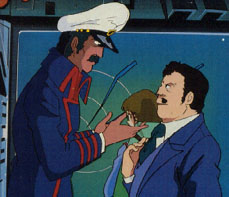
The Ministry of Terrestrial Defence is mentioned (42), and is later referred to as the 'Ministry' (47, 48). Therefore there are several executive departments called ministries. As well as a Ministry of Terrestrial Defence, there may be a Ministry of Economic Affairs, Ministry of Humanitarian Affairs, and so on. The staff of the ministries should, and no doubt would, constitute an apolitical career civil service. The existence of ministries implies that they are headed by people called ministers.
Some people claim that Leonard's and Emerson's moustachioed civilian superior is called the Prime Minister, but this comes from SDCSC, not Robotech. The existence of a Prime Minister would suggest that the government operates in a parliamentary fashion (i.e. executive government is carried out by a committee whose members are separately but simultaneously legislators). However, in spite of its success at national and sub-national level, it is not feasible for a world government to operate in such a fashion. The form of government most likely to be the most successful at an international level is one in which (as in the Swiss system) the heads of executive organisations are appointed by the legislature without them being members of the legislature.
In Robotech this person is addressed as 'Your Excellency' and neither his name nor title is ever mentioned. 'Your Excellency' is a form of address usually applied to heads of state of republics, viceregal governors and governors-general, ambassadors, Commonwealth high commissioners, the Commonwealth secretary-general, and prime ministers of a number of Asian countries. However, a state may decide to apply this form of address to any of a number of senior positions within its system of government. This is consistent with this character being a senior member of the government with authority over Leonard and Emerson. The best explanation is that he is the Minister of Terrestrial Defence. He is the only civilian who Leonard and Emerson are seen answering to or participating in meetings with, which suggests that he is their immediate civilian superior, the defence minister. Subject to the Senate and the United Earth Council, the Minister of Terrestrial Defence is in overall charge of the UEF and the Ministry of Terrestrial Defence.
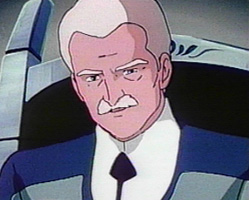 His Excellency |
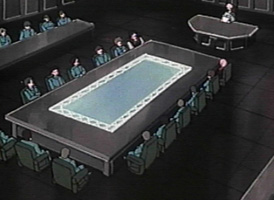 His Excellency presiding at a defence meeting |
There are a number of references to one or more government 'councils':
- united Earth governing council (24);
- united Earth council (20, 23);
- council of the united Earth government (43);
- council (51).
A number of these references may be merely descriptive and not official designations.
In episode 20, Gloval refers to the 'united Earth council' in a context that implies that it is an official name. In this instance the United Earth Council is the body that orders SDF-1 to leave Earth.
The inclusion of the word governing may imply a specifically executive role. There needs to be a means to ensure that executive government is conducted in a co-ordinated fashion. The best way of achieving this in the context of the UEG is for the peak executive authority to be a council comprising every minister who is in charge of an individual executive portfolio. Each minister runs his/her portfolio on his/her own responsibility subject to the collective decisions of the council, the chairmanship of which rotates between its members. (This is how the executive government of Switzerland is organised.) This is probably the best explanation for the United Earth Council, otherwise referred to as the united Earth governing council and council of the united Earth government.
(Note that the 'governing council' of senior military officers in episode 15 is a separate body that governs only the armed forces. See below.)
There is some debate about the relevance of the United Nations to the world government. The acronym 'UN' appears a number of times in the animation. 'U.N. SPACY' appears on Hunter's medal certificate (8) and the fuselage of the aircraft designated 'Pelican Mother' (32).
There is no dialogue reference to the United Nations in relation to the world government and some fans deny even the possibility that the world government is a reformed UN Organisation. Some also state that the appearances of 'U.N. SPACY' and other such terms must be treated as if they do not exist. It must be pointed out that whether to accept 'U.N.' as meaning United Nations is a separate issue from whether to accept 'SPACY' and other terms accompanied by 'U.N.'
People may point to the common use of the term 'United Earth Government' instead of 'United Nations Government', but all this indicates is the name of the government, not the global state that it governs – which could be called the United Nations. Some cite the comment in episode 29 about the UN having failed to preserve peace as proof of its abolition. But the comment is accurate in the context of the real world, yet the UN still exists. That it hasn't prevented the many wars that have occurred in the last 65 years is not proof of non-existence.
A reformation of the UNO is the most plausible means of creating a world government should its member states want to do so. The Senate could be a reformed General Assembly, and the departments of the Secretariat could become the ministries.
I've found that whether the world government was formed through the UNO or whether the UNO was superseded by the unrelated UEG does not make much difference. But if one accepts the latter, what should be done about appearances of 'U.N.' in the animation (other than ignoring them)? One explanation for the appearance of 'U.N.' on craft is that it is a code identifying a command to which the craft belong in the way US Navy air wings are identified. This doesn't account for 'U.N. SPACY' on Rick Hunter's medal certificate (8) and 'Pelican Mother' (32), 'U.N. AMY' (note: not 'ARMY') on a military vehicle (34), or similar appearances. UN could stand for something other than United Nations and SPACY and AMY could also be abbreviations. However, the most simple, obvious and tidy conclusion to draw is that the UEG is the government of a union of nations called the United Nations.
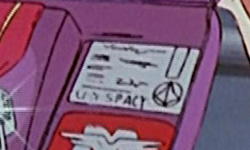 Episode 8 |
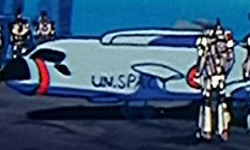 Episode 32 |
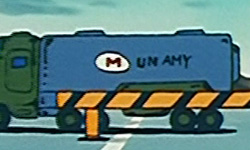 Episode 34 |
There are, broadly speaking, two basic types of chain of command in military organisations: one for providing forces, the other for conducting operations. The force-providing function is best performed on a specialised basis, hence navies, armies and air forces. Operations require different combinations of different types of forces at different times for different missions. Force-providing organisational arrangements need to be long-term and organisational arrangements for the purposes of operations need to exist for only as long as missions require.
An obvious real-world example is the 'unified command' arrangement of the United States. The heads of the US Navy, Army, Air Force and Marine Corps are responsible for raising, training, organising, equipping, maintaining and administering their respective services, whereas American military operations are commanded by other officers through a different but simultaneous chain of command on a joint basis ('joint' means involving parts of more than one service).
US warships assigned to the US Pacific Command belong to the same US Navy as US warships assigned to the US Northern Command, the US European Command, the US Central Command, and so on. US infantry battalions assigned to the US Pacific Command belong to the same US Army as US infantry battalions assigned to the US Northern Command, the US European Command, the US Central Command, and so on. The heads of these commands are in charge of American military operations, not the heads of the services. There can be joint organisations for other purposes as well.
Joint entities and this type of command arrangement are normal throughout the world's military organisations. Parts of different services are assigned to different joint commands from time to time according to the commands' requirements, the availability of forces and other factors.
The same principle applies to the posting of individuals outside the chain of command of the parent service. A member of a service may be assigned to a joint organisation or even an organisation within another service, or to a non-military government organisation. Such a person would still be responsible to the head of the parent service insofar as being a member of that service is concerned but would be responsible to an officer of another service, or to a civilian official in the case of a non-military organisation, insofar as the duties of the posting are concerned.
This illustrates the absurdity of the idea of the Southern Cross and Expeditionary Force being unrelated organisations as opposed to commands within the (same) UEF. If the US military were organised by the average Robotech fan, there would be several separate US Navies, several separate US Armies, several separate US Air Forces, and several separate US Marine Corps! One each for the Northern Command, European Command, Africa Command, Transportation Command, Strategic Command, etc., with each of these commands being entirely separate from the rest of the US military.
The service to which a commander of a joint command belongs is typically the service that provides the dominant contingent (it doesn't necessarily have to be the case). It can be expected that a naval officer will be appointed to command a largely maritime joint command, for example, and that the job of commanding a joint entity in which the parts of the services involved have an approximately equal role would alternate fairly equally between officers of those services.
It is sensible that the UEF comprise several services. The UEF would have been established not just for space combat, but also to deal with national and international conflicts, and to provide a last line of defence in the event of an alien attack. We see the UEF fighting on Earth in the flashback scenes of episode 33 (before the war against the Zentraedi).
Though the demarcation has become blurred, generally sea, land, and air warfare still require very different methods, organisation, equipment, doctrines and skills. This is why we have navies, armies and air forces in the real world. The UEF operates in four environments (sea, land, air, and space), so there are four services, each with primary responsibility for providing forces for one of the four environments. These services are the Navy, Army, Air Force and Spacy. There is a case for not having an air force (to which I'm sympathetic), instead splitting all aviation between the other services, but it is a controversial point so the Air Force will be covered in this article.
Though they have individual identities, as parts of a larger, single, unified entity there would be considerable commonality. What is required is balance between the concept of individual services and the concept of a unified force so that the benefits of both can be exploited. Some have suggested that the armed forces of the world government consist of only one service comprising a space force with a ground arm and an air arm, and there is some basis for this argument, but the evidence in Robotech leans much more towards a multi-service organisation. Indications (major and minor) include:
• There isn't the slightest evidence that Prometheus and Daedalus don't belong to the UEF or that there are military personnel aboard these ships and/or SDF-1 who are not members of the UEF.• Navy-style and equivalent army-style rank titles (e.g. admiral and general) are applied to different members of the UEF (see Ranks of the Armed Forces of the World Government), and parallel ranks wouldn't be worth the bother for only one service (especially considering the need for translating UEF ranks into various languages).
• It is implied that the UEF is more than large enough to warrant dividing it between several services to ensure effective 'force-providing' command arrangements.
• General Leonard refers to the 'Joint Chiefs' in episode 58. In the real world this term normally refers to a committee comprising the head of the US armed forces, his deputy and the heads of the Navy, Army, Air Force and Marine Corps, so there can be no doubt that Leonard is referring to the UEF's equivalent. The group of senior officers to which Captain Gloval and Lieutenant-Commander Hayes report in episode 15 is referred to by the narrator as the 'chiefs of staff' (16).
Unfortunately there are a number of instances in the dialogue where the words 'army' and 'soldier' are associated with people who do not belong to a land-warfare service. This is the result of slapdash translation (for 'army' read 'military', for 'soldier' read 'serviceman'). This is sometimes cited as evidence for a single-service organisation, but it would be nonsensical for such organisation to be called an 'army'. There are instances in the real world where people refer to other services as 'armies' or (more commonly) their members as 'soldiers' (which never ceases to annoy me). So some instances where this happens in Robotech can be explained as the product of ignorance on the part of civilian characters. Other instances can be reconciled by concluding that 'army' refers to a field army. Field armies are operational formations that may be part of a joint command. It may be that the definition of the word 'soldier' has been deliberately broadened in the UEF owing to the relevance of languages other than English in which the approximate equivalents of 'soldier' have broader definitions.
When confronted with conflicting concepts in the series that cannot be reconciled plausibly, we must disregard the least significant of the conflicting evidence. In this case the least significant of the conflicting evidence is the mistranslation.
The term 'Spacy' appears a number of times in the animation. The contexts of its appearances imply that it is the name of the space service of the UEF. Some people object to it on the basis that it is merely a palimpsest from Macross, but nearly everything in Robotech is a palimpsest. Harmony Gold could have excluded appearances of the term if it wanted to, but it didn't. Nothing in the 85 episodes should be ignored – no matter how much we may dislike it – as long as it can be reconciled in a reasonably plausible way with everything else in the dialogue and animation. 'Spacy' is not inconsistent with anything else in Robotech. A few fans refer to space forces as belonging to a navy, which is ludicrous. Navies are, by definition, maritime services. An alternative is 'Space Force' (9). However, given the number and context of appearances of 'Spacy', trying to avoid taking it to mean anything other than the UEF's space service is pointless.
 Episode 8 |

Spacy recruitment poster in episode 11 (Say what you like about Minmei but she's cuter than Lord Kitchener.) |
 Episode 32 |
These services exist throughout the whole of Robotech, and there is never more than one of each service. Commanders Fokker (TMS), Tessel (TRM) and Bernard (TNG) are all members of the same service, regardless of which operational commands they happen to be assigned to.
Citing the probability of considerable American influence in the creation of the UEF, some fans propose the existence of marines. Few nations have marines and there's no good reason why any marine corps established after the 19th Century should exist. The Royal Marines have a rich history spanning about three and a half centuries, but they were saved from oblivion only after being reduced to a brigade-size commando force. Even today's most powerful marine corps, the US Marine Corps, was almost abolished after the Second World War (one of about fifteen attempts to abolish it), despite recent successes in that war and a history of about 1 ¾ centuries. The fact is, whatever marines can do, navies and armies can do if given the resources. As a USMC sergeant-major once put it, 'America doesn't need a marine corps, America wants a marine corps'. To further confuse the issue, some fans even claim that marines are space forces! Marine means sea. One clown even claimed that the UEF includes a coast guard! Needless to say, the function of a coast guard is a purely national concern (and many sea-side nations do without them). Whatever the degree of American influence, it would certainly not extend to forcing the world government to create hugely expensive organisations of such superfluity.
There are several indications that the Spacy has a ground forces arm that is conspicuous by the fact that all its members have the same rank titles as members of the Army and it applies Army formation, unit and sub-unit designations:
• Dana Sterling's command is deployed, and operates competently, in space combat despite having been mostly confined to land operations during the war.This entity should not be seen as an individual (or quasi-individual) service, which would be wasteful and pointless. Its primary function is to provide forces that are adept in both space and land combat (including close air support) for the space/land equivalent of sea/land operations undertaken jointly by navies and armies. Though it is a part of the Spacy, necessity dictates that it uses Army organisational principles and, as a result, the government accepted the proposal that its members be distinguished from those of the rest of the Spacy by having the same rank titles as the Army.• Dana Sterling's command has (unlike other space forces) the same officer ranks as the Army despite operating in space.
• A captain of a space ship holds the rank of major (47) instead of a navy-style rank. He could succeed to command only if he's qualified to do so, which means being a member of the Spacy.
• The conduct of the war against the Masters is the responsibility of generals Leonard and Emerson rather than officers of admiral rank.
• General Reinhardt has a prominent role in the Expeditionary Force.
• In episode 15 Colonel Maistroff announces, 'I'll be commanding the bridge [of SDF-1] while the captain is off the ship'. This suggests he has a bridge watch-keeping certificate, which is not a qualification normally possessed by Army or Air Force personnel.
• 'Tactical armoured space corps' (40, 41, 52) and 'tactical space corps' (58) are mentioned. Lieutenant-Commander Scott Bernard, a Spacy officer, refers to himself as a member of 'the 21st armoured tactical assault corps' (62) and, although his squadron could have been assigned to support a formation of another service, this statement would fit the context of a Spacy ground forces arm better.
The existence of this organisation does not preclude the presence of forces of other services on board space ships.
There are several references to a council that deals with defence matters:
- defence council (20);
- war council (50, 51).
The 'Defence Council' (20), also referred to as the 'war council' (50, 51), is best explained as being like defence/security councils of national executive governments. It comprises the Minister and senior members of the UEF, MTD and other relevant government bodies, and is primarily a consultative body.
There are several references to a committee of senior military officers:
- governing council (15);
- chiefs of staff (16);
- Joint Chiefs (58).
The head of each service must be its chief of staff as there is a reference to the 'Joint Chiefs' (58) and the 'chiefs of staff' (16) rather than references to a service's head as a 'commander', 'commander-in-chief', 'supreme commander', or by a title of another kind.
In addition to the staff that administers each service there must be (as in the real world) a joint staff responsible for matters affecting more than one service and the overall co-ordination of the UEF. Its chief is the chairman of the Joint Chiefs of Staff, the principal military adviser to the government and professional head of the UEF. This position is filled by a senior officer from each of the services on a rotational basis.
In some nations the head of the armed forces is merely a chairman of the chiefs of staff committee, while in others the senior serving officer commands the entirety of the armed forces. Having a mere chairman is outdated and results in an inadequately effective staff. Having an overall commander is by no means a terrible idea, but it can result in excessive centralisation, especially problematic in a large defence organisation, and the infringing of the services' heads' ability to run the services.
The group of senior military officers to which Captain Gloval and Commander Hayes make their report in episode 15 is referred to in episode 16 as the 'chiefs of staff'. However, it is referred to (purely descriptively) during episode 15 as the 'council', 'Earth council' and – weirdly – the 'governing council'. 'Governing' is presumably a mistranslation of something like 'commanding' but it can be taken to refer to its role of governing the armed forces. This collective function discounts the possibility of an overall military commander of the UEF and indicates that the chiefs of staff are responsible to the Minister collectively as the Joint Chiefs of Staff, as well as individually. The Joint Chiefs of Staff is the highest purely military entity in the defence organisation.
In episode 15 these officers appear on screens in a six-sided room, so – whatever minor inconsistencies there may be in their depiction – it is probable that there are six members of the Joint Chiefs of Staff, i.e. the chief of the joint staff of the entire UEF (chairman), his deputy (deputy chairman) and the chief of staff of each service. Admiral Hayes (Lisa's father) is one of these officers.
 |
 |
 |
 |
 |
 |
For operational purposes forces belonging to the services of the UEF are assigned to various top-level operational commands within the UEF ('top-level' meaning the operational commanders responsible directly to the government). There could be a European Command, a Joint Logistic Command, a Pacific Command, and so on.
Units assigned to one such command belong to the same services as units assigned to another. For example, the commander of an Air Force squadron assigned to the European Command is responsible to the head of the Air Force insofar as the squadron belongs to the Air Force, and separately responsible to the commander of the European Command insofar as operational matters are concerned. If the squadron were later transferred to the Pacific Command, the squadron would still be in the same Air Force and responsible to the head of the Air Force, but now responsible to a different operational commander. Forces are assigned to different commands from time to time according to the commands' requirements, the availability of forces, and other factors.
General Leonard is referred to as a supreme commander several times, indicating that this is the appointment title of the officers heading the 'top-level' operational commands. This is a conventional title for commanders of exceptionally large joint operational commands, particularly multi-national ones. For example, General MacArthur was Supreme Commander, Allied Powers during the occupation of Japan. During the Second World War Admiral Lord Mountbatten was Supreme Allied Commander, South-East Asia. The overall commander of NATO forces is titled Supreme Allied Commander, Europe.
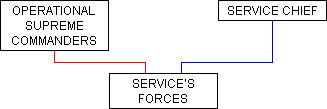
Having established that the Southern Cross (35, 38, 46, 47, 50, 52, 53, 54, 59) is part of the UEF, we now turn to the separate issue of what the Southern Cross actually is. Conventional wisdom has it that 'Army of the Southern Cross' (39, 42, 45, 47, 48, 49, 51, 53), 'Armies of the Southern Cross' (38, 61), and 'Southern Cross' mean the same thing. This raises several questions. Why three different titles? Why 'army' and 'armies'?
Southern Cross appears to be the joint operational command responsible for monitoring space and conducting operations against the Masters. So why does a space-oriented command consist entirely of one or more armies? Solution: it doesn't. I propose that Southern Cross is the name of the top-level joint command responsible for conducting space operations in the solar system, and that it includes (not exclusively) one or more 'armies' in the sense of ground-oriented operational formations (which are presumably largely or entirely of the Spacy's ground arm). There are armies of the Southern Cross, fleets of the Southern Cross, and so on. (It may not be a perfect solution to the problem, but, as with many things in Robotech, a perfect solution seems impossible.)
General Leonard is the Supreme Commander of the Southern Cross during the events of episodes 37 to 60.
Because there is a dialogue reference to the Southern Cross in episode 35, we know that an entity with this name existed prior to the destruction of SDF-1. There's no reason we can't conclude that SDF-1 is assigned to the Southern Cross from episode 1.
I've no idea why it should have been called the Southern Cross, but the name does have an astronomical connotation (it also has the same initials as Space Command, which would be the obvious choice of name). Military organisations often like to give things silly names (and it hardly seems odd compared with a Melbourne railway station being renamed 'Southern Cross Station' in 2005).
Following the war against the Zentraedi an expeditionary force is established to journey to the home world of the Robotech Masters. Its deployment takes place after the events of episode 36 and before the events of episode 37. Expeditionary forces in the real world are simply operational commands comprising various units (of one or more services) that a mission requires, and this is what Robotech's expeditionary force must be. The Expeditionary Force is another of the 'top-level' operational commands.
There are a number of references with 'expeditionary' relevance:
- expeditionary force (62, 64, 68, 84, 85);
- expeditionary forces (70);
- Robotech expeditionary force (64, 68);
- expeditionary mission (61);
- pioneer expedition (47);
- pioneer mission (47);
- SDF-3 pioneer mission (47);
- the SDF-3 was Admiral Rick Hunter's command (78);
- Admiral Hunter's Earth defence expedition (62).
Several of these terms may refer to the same thing and are not necessarily official designations.
Whether 'Robotech Expeditionary Force' should be considered a formal name in the context of the TV series alone has been debated extensively. It's not a plausible title and the phrase appears in only two episodes. On the other hand, its appearances are in a quasi-official context. Whether it is a name or merely describes a force with an expeditionary purpose that is equipped with Robotechnology is not significant as far as organisational matters are concerned.
Different commands within the Expeditionary Force may have different 'expeditionary' missions. The deployment of Mars Division to Earth at the beginning of TNG (61) can be said to have constituted an expedition in itself, and this is what is meant by 'Admiral Hunter's Earth defence expedition' (62).
It is not clear in the TV series who commands the Expeditionary Force and it's to be expected that it had several commanders throughout its long existence. Major Carpenter refers to General Reinhardt as 'commander of the mission' (47), but to which mission he refers is not indicated. Lieutenant-Commander Scott Bernard refers to Admiral Rick Hunter numerous times in TNG in connection with an expeditionary force command.
There were several deployments of Expeditionary Force forces back to Earth following the arrival of the Masters, including Major Carpenter's ship, Colonel Wolfe's command, and Mars Division.
Although the following information is presented in separate sections about sea/space, air and ground force organisation, I must emphasise that, even at low levels in a chain of command, commanders may exercise operational command or control over forces of different services, either as part of their commands (which may be joint task commands or similarly 'equal partner' entities) or on some form of secondment. For example: the commander of an Army amphibious division may have Navy warships to provide transport and fire support; the commander of an Air Force patrol wing may have an Army anti-aircraft battery to provide airfield defence; the commander of a Navy fleet may have an Army amphibious division to provide landing forces and an Air Force patrol wing to provide airborne surveillance.
For obvious reasons, naval organisational principles must be followed in space forces such as those of Robotech.
In navies of the English-speaking world each ship and submarine is commanded by an officer known as the commanding officer (CO), also known as the captain, regardless of rank. Which rank is commensurate with a particular command appointment depends largely on the size of the ship's company (crew). The largest ships of the UEF may have crews of a size that require captains of ranks well above captain.
Each ship and submarine has a second-in-command known as the executive officer (XO). For administrative purposes the ship's company is divided into departments defined according to function. The names of departments, and their assigned functions, differ between navies and even between ships of the same navy. The following is a typical arrangement:
• Warfare Department. Navigation and ship-handling, tactics, electronic warfare, aircraft direction, communications, operation of sonar, radar, weapons and other tactical systems.There must be crew members on duty at all times, day or night, at sea or in harbour, so each day is divided into periods called watches, and different crew members are on duty during different watches. Traditional naval watches:• Supply/Logistics Department. Catering, stores, finance and clerical tasks.
• Marine Engineering Department. Propulsion and other mechanical systems, electrical generation and distribution, heating/air conditioning and ventilation, water supply, sanitation and ship's structure.
• Weapon/Electronics Engineering Department. Maintains weapons and other electronic systems.
• Air Department. Applicable to ships that carry aircraft.
• Executive Department. General administration and pretty much anything that isn't substantial enough to warrant its own department, such as medical matters, education and training discipline and chaplaincy. The executive officer is the department head.
During each watch there is an officer of the watch (called the officer of the deck in the USN and USCG) who is in charge of the ship's movement and safety. The OOW is directly responsible to the commanding officer, and in regard to the performance of duties as such is in charge of all crew members other than the commanding officer and executive officer. The OOW is not relieved of his/her responsibilities/duties as such by the mere presence of a more senior officer.
The creators of Robotech and the three Japanese shows from which it was adapted didn't have a realistic concept of organisation and procedures aboard ships. Why are bridge officers acting as aircraft controllers? Why is Captain Gloval on the bridge instead of in the operations room during action? Why does SDF-1 have a separate bridge and operations room in the first place (and why is the bridge in such a gratuitously vulnerable position)?
SDF-1 appears not to bother with OOWs at all, but there has to be someone in charge when Gloval is not on the bridge. In episode 15 Colonel Maistroff announces he'll be 'commanding the bridge while the captain is off the ship', but it's implied that Maistroff is not accustomed to doing this. Major Carpenter's sidekick may have been the OOW at the time of his ship's suicide mission, but he could have been the executive officer or held a different position altogether.
Lieutenant-Commander Lisa Hayes is referred to as the 'first officer' of SDF-1 on more than one occasion (6, 7, 15). The most obvious interpretation is that first officer is synonymous with executive officer. However, Hayes is far too junior for that position. In Commonwealth navies the senior seaman officer ranking below commander in a ship's company is traditionally known as the first lieutenant. Where the commanding officer is of or below the rank of commander, the first lieutenant is also the executive officer. Where the executive officer is above the rank of lieutenant-commander, executive officer and first lieutenant are separate positions. So we could easily surmise that 'first officer' is synonymous with first lieutenant rather than executive officer. The difference in title is easy to explain: first lieutenant is a rank in the Spacy so, in order to avoid confusion, the position is called first officer instead. However, the fact that Hayes appears to hold the lower of two grades of lieutenant-commander until episode 13 means that she's too junior for this position as well! There doesn't seem to be any evidence that Hayes is 'first' of anything, so the definition of this term remains a mystery.
When it comes to organisational entities comprising more than one ship or submarine, naval organisation typically has a very conspicuous difference between operational and non-operational command arrangements. Operational organisation generally takes the form of an arrangement of (in ascending order) 'task elements', 'task units', 'task groups' and 'task forces' (such terms are also used for joint task commands). This is a very flexible system that allows units of a very different nature to be mixed to provide the right balance of capabilities for a particular purpose, and these formations are frequently constituted on a short-term basis.
Conventional real-world sea forces operational chain of command:
| Command | Typical rank of commander* |
| Fleet | Admiral or vice-admiral |
| Task force | Rear admiral |
| Task group | Commodore (or equivalent flag rank) or captain |
| Task unit | Captain or commander |
| Task element | Commander or lieutenant-commander |
| Ship/submarine | from lieutenant to captain |
* Owing to the flexibility of the system, ranks commensurate with naval task
command positions can vary considerably, so this should be viewed as a rough guide.
Task forces are normally grouped into fleets (which themselves may be grouped into larger entities also called fleets, e.g. the US Seventh Fleet is part of the US Pacific Fleet). However, Robotech has 'Mars Division' (61, 68, 73). Therefore in the UEF a fleet division (typically commanded by a vice-admiral) comprises several task forces, and a fleet (typically commanded by an admiral) comprises several fleet divisions.
Please note that the word 'fleet', and 'armada', are used to describe large groupings of ships (and many other things) irrespective of official formation designations.
The arrangement of commands for providing ships and submarines to task commands varies. For example, the United States Navy (at the time of writing) groups its forces in two sets (Pacific and Atlantic) of Surface, Submarine, and Air commands with a whole-of-type commander for each of the three types. The surface and submarine type commands are divided into groups, which are further divided into squadrons comprising individual ships or submarines. There are also support elements.
The Royal Australian Navy (at the time of writing) has a functional command structure rather than a type command structure. In this system forces are grouped according to function rather than the 'floats, flies, or submerges' basis: frigates and destroyers, patrol boats, submarines, aircraft, mine warfare (includes ships and diving teams), amphibious warfare and supply ships, and hydrography.
The Royal Navy had a type command arrangement but it was ineffective owing to the fact that ships' captains rarely had contact with their squadron commanders and their staffs. Each ship and submarine is now assigned to a 'fleet waterfront organisation' that may consist of ships and submarines of any number of different types and roles. There is one fleet waterfront organisation each for the Fleet Air Arm, Royal Marines and Royal Fleet Auxiliary, and there are three mixed flotillas for the other forces. The UK's fleet commander has senior officers on his staff to provide guidance concerning submarines, aviation, marines, etc.
Given the global nature of the world government's navy, the decentralised and mixed RN-style system is the most feasible. However, there is still a need for authorities responsible for dealing with matters relating to each of the different capabilities across the service, so there would be positions for this purpose. The different capabilities should be differentiated according to function (RAN-style) rather than type. A similar or hybrid arrangement would probably apply in the Spacy after the events of TMS, but it probably would be more likely to be organised on a functional basis in the early years of its existence.
The RN-style 'home base' system fits with the fact that Mars Division ships have 'Mars Base' written on their hulls, implying that the identity of the home base is significant. It cannot refer to a base on the planet Mars as that planet has nothing to do with the Expeditionary Force's mission. The base must be located far beyond Earth's solar system, and is presumably the space station seen in episode 61 with 'Mars III' on its hull. Some mecha in TNG have 'MB' written on them, which may or may not refer to Mars Base. Contrary to some people's belief, no other base or division named after a Roman god (or planet) is mentioned in the TV series (though a Jupiter Section is).
Except for small base commands forces assigned to a base would have to be divided between different administrative formations within the base command. The RAN-style 'functional' differentiation referred to above is the most appropriate basis for allocating forces to formations. However, how forces are allocated to formations within a base command would depend on their quantity and variety. The best rationale for allocating forces to formations in one base command is not necessarily the best way for another. Inefficiently narrow or cumbersomely broad chain of command arrangements must be avoided to the extent practicable. The general principle that the larger the quantity the less diversity there should be at each successively lower formation level is sensible. For example, a small number of frigates and destroyers could constitute a single squadron, whereas a large number could constitute a group divided between several frigate squadrons and destroyer squadrons.
The basic organisational entity in armies is the unit (which normally has 500 to 800 people, depending on the type), which is divided into sub-units. Units are combined in different ways to form formations. (The word 'unit' can be used in a much broader sense, but in this section it will refer only to a battalion-level command.)
Unit designations vary between different corps. A corps (pronounced 'kor') is a branch of the service. A corps comprises the personnel who have a specific function. For example: Infantry Corps, Armoured Corps, Engineer Corps, Air Corps, Legal Corps, Medical Corps, etc. Robotech's Global Military Police is one of these corps. Infantry, Ordnance, Intelligence and Military Police units are normally called battalions, whereas Armour, Signals, Air and Transport equivalents are usually called regiments. In some cases units are just called 'units'.
Battalions comprise several companies consisting of platoons, which are further divided into sections (sections are called squads in US forces). An infantry section normally comprises eight to twelve men. Battalion-equivalent regiments normally comprise several squadrons consisting of several troops (strangely, in US forces 'squadron' and 'troop' are equivalent to battalion and company respectively). Artillery regiments comprise several batteries, each consisting of several sections (artillery sections are equivalent to platoons).
Units may be augmented by placing additional sub-units under the operational authority of the unit's commander. For example, a tank squadron can be placed under the operational authority of an infantry battalion commander. The same principle can be applied at company-level by attaching platoon-level sub-units. Task commands can also be established by bringing together sub-units without including a complete unit.
Battalion-level entities are combined to create formations called brigades. For example, an infantry brigade will consist principally of infantry battalions, but will have other elements as well (e.g. an artillery regiment, signal squadron, engineer squadron, etc.)
In some armies battalion-level entities are combined to form organisations called regiments (not to be confused with battalion-equivalent regiments). In some cases such regiments constitute a command (e.g. an army may have regiments instead of brigades). This arrangement is becoming even less common owing to the superior versatility, economy and autonomy of brigades. In other cases (as is almost always the case in the English-speaking world) a multi-battalion regiment is merely an institutional 'family' of battalions (the battalions are not assigned to formations under a regiment commander). It is unlikely that the UEF would have regiments of either of these types.
Brigades can be combined to form divisions, which in turn can be combined to form corps.
This kind of corps is very different from 'corps' in the sense of a branch of a service, so be careful not to confuse them. A corps in the sense of an operational formation consists of elements of many of the other kind of corps. Formation titles in Robotech beginning with 'tactical', such as 'tactical armoured corps', 'tactical space corps', and 'tactical armoured space corps', are corps in the sense of operational formations. This is further indicated by the use of designations such as a letter of the phonetic alphabet (alfa, bravo, charlie, delta, etc.) and numbers to distinguish corps of the same role, e.g. 'Fifteenth Tactical Armoured Corps' (38, 43, 54).
Corps may be combined to form armies (often referred to as field armies in this sense), which may themselves be combined to form army groups. Please be aware that the word 'army' has different meanings. An army may be a service (as in Navy, Army and Air Force), it may be a formation (such as the US Eighth Army, which is part of the US Army) and the word can be used to describe just about any large group of something, e.g. 'an army of reporters at a press conference'. Care must be taken to not confuse the contexts.
Conventional real-world ground forces chain of command:
| Command | Typical rank of commander | ||
| Army group | Field marshal (or equivalent general rank) | ||
| (Field) Army | General | ||
| Corps | Lieutenant-general | ||
| Division | Major-general | ||
| Brigade | Brigadier(-general) or colonel | ||
| Battalion | Regiment | Regiment | Lieutenant-colonel |
| Company | Squadron | Battery | Major or captain |
| Platoon | Troop | Section | (First) lieutenant or second lieutenant |
| Section | Section | Detachment | Corporal (or equivalent sergeant rank) |
Unfortunately ground force organisational terminology in Robotech is very confused and contradictory.
There are a number of references to one or more 'armies of the Southern Cross':
- 'army of the Southern Cross' (39, 42, 45, 47, 48, 49, 51, 53);
- 'armies of the Southern Cross' (38, 61).
An 'army of the Southern Cross' is an army in the sense of a formation (field army). The phrase 'commander of the army of the Southern Cross' is spoken in episode 39. 'Armies' is the plural of 'army'; therefore 'armies of the Southern Cross' refers to several such formations assigned to the command known as the Southern Cross. These may or may not constitute one or more army groups. There is a reference in TMS to a 'Southern Cross group' (35), which may refer to any of a number of different organisations within the Southern Cross.
That there are references to 'the' (as opposed to 'an') army of the Southern Cross does not mean that there is only one. 'Armies' is in the dialogue. It's just a case of referring to one of the field armies in a context in which only that one is relevant (if you say 'I'll put the kettle on' when you want a cup of tea, I won't assume you own the only kettle in the universe). (Regarding plural as a dialogue error would make references to 'the' army less awkward.)
One of these field armies includes Dana Sterling's command. Sterling commands a cavalry troop (a platoon-level sub-unit). However, it is called a troop only in episode 45 (and even then it may actually be 'troupe'). It is most frequently called a 'squad' and a 'squadron', though neither of these designations is correct. But if that weren't bad enough it is also called a division and even a corps (as well as being part of a corps). The references to it being a division and a corps are rare enough to ignore as dialogue errors. Unfortunately it would be too drastic to do the same with the numerous 'squad' and 'squadron' references. Therefore we must resign ourselves to using not just one but both of these terms to refer to a troop. There is a reference to a 'company of destroids' (7), so, because destroids are Armoured Corps mecha, we can conclude that in the UEF 'company' is used to define what 'squadron' should.
A platoon-level entity is usually commanded by a lieutenant, but there are instances where captains do so (the armies of India and Canada are particularly keen on it, apparently), as is the case with Sean Phillips. A good explanation is that he was scheduled to be transferred a short time after having been promoted to Captain (he's also referred as a lieutenant which suggests that he is an acting captain pending official confirmation of promotion). It's possible that it was intended he remain with the Fifteenth in order to supervise the inexperienced Dana Sterling prior to her assuming command.
There is a multitude of contradictory titles of the formations to which Sterling's command is assigned. The problem can be minimised by supposing that Sterling's command gets reassigned between different formations at some point. Also, one or more of a number of very similar titles can be ignored fairly easily. The division is called the Fifteenth Tactical Division (38), Fifteenth Division (39), Fifteenth Armoured Division (39) and Fifteenth Tactical Armoured Division (39, 49, 57). The corps is identified as the Fifteenth Tactical Armoured Corps (38, 43, 54), Fifteenth Tactical Army Corps (45), Fifteenth Tactical Corps (42), Fifteenth Armoured Tactical Space Corps (53) and Alfa Tactical Armoured Corps (43). It's possible that the latter is actually Alpha Tactical Armoured Corps (as in SDCSC). However, it is extremely unlikely that Greek letters would be used for formation designations instead of the English phonetic alphabet (alfa, bravo, charlie, delta, etc.), especially considering the need to abbreviate.
In episode 50 the word 'infantry' is associated with Dana Sterling's command. This is a dialogue error, though in a way Sterling's command could be considered a troop of mounted infantry. Prior to mechanisation, mounted infantry were soldiers who rode horses, but – unlike cavalry – they dismounted on the battlefield and fought as riflemen. This could be considered the equivalent of veritech tanks transforming to battloid mode, battloids being like 'giant riflemen'.
'Squadron' has very different definitions in the organisation of armies, naval surface and submarine forces, and naval and air force aviation. In naval and air force aviation the squadron is the basic organisational entity. Squadrons are divided into flights, which may themselves be divided into sections.
A wing has several squadrons and a group has several wings (except that in the USAF 'wing' supplants 'group' and vice versa). There is more variation in titles of larger formations, which include 'tactical air forces', and 'commands', e.g. the USAF's numbered air forces (e.g. Ninth Air Force) and the RAF's (now superseded) Strike Command. Many countries' air forces use ground formation designations, e.g. air brigade, air division, air corps and air army.
A squadron can be part of one formation for operational purposes and part of an equivalent formation for the force-providing function. For example, US Navy air squadrons are assigned to 'type wings', the force-providing entities. USN type wings comprise squadrons of the same function, e.g. strike wing, airborne early warning wing, electronic attack wing, and so on. A carrier wing, on the other hand, comprises the squadrons assigned to an aircraft carrier, which come from a variety of type wings (a variety of capabilities being required for operations), and it's the carrier's wing commander who commands this entity.
Conventional real-world aviation forces chain of command:
| Command | Typical rank of commander (Air Force ranks shown)* |
| Group | Air vice-marshal / major-general or air commodore / brigadier(-general) |
| Wing | Air commodore / brigadier(-general) or group captain / colonel |
| Squadron | Wing commander / lieutenant-colonel |
| Flight | Squadron leader / major |
| Section | Flight lieutenant / captain |
* Note that group captain, wing commander and squadron leader
are ranks and as such do not indicate a command appointment.
Unfortunately in Robotech the usage of these terms is a preposterous mess. There is a complete lack of consistency, so I found that even trying to adhere to the terms used most frequently was impossible. Sometimes a particular grouping of aeroplanes was referred to by several different designations in the same scene! 'Team', 'squadron', 'wing' and 'group' are all used interchangeably. As a result of this lack of consistency I reluctantly came to the conclusion that the only feasible way of dealing with this problem is to completely disregard the unconventional usage where it occurs.
In episode 8, newly-commissioned Third Lieutenant Rick Hunter becomes the commander of one of Skull Squadron's sections, comprising himself, Corporal Ben Dixon and Corporal Max Sterling. Sections are traditionally designated by colour and this is applied in Robotech. Hunter's section is called 'Vermilion', Hunter is Vermilion Leader, Dixon is Vermilion 2 and Sterling is Vermilion 3. However, it's not called Vermilion Section but 'Vermilion Squadron' (10, 16) and 'Vermilion Group' (9, 12). There are numerous references to so-called 'squadrons' by other colours. Skull Squadron is mistakenly referred to as Vermilion Squadron twice in episode 13 (while Hunter, Dixon and Sterling are on 'R and R'). In episode 8 Lisa Hayes says that Rick Hunter was promoted to the rank commensurate with the appointment of group leader, and in episode 10 he is referred to as a group leader. Groups should contain dozens of aircraft, not merely three.
In episode 13 Hunter is promoted to Second Lieutenant and Dixon and Sterling are also promoted. Given that Hunter became a squadron commander in episode 19 it is logical to conclude that he became a flight leader at this point.
Some alternative explanations for internal squadron hierarchy in Robotech:
|
Squadron CO
Flight leader Section leader Pilot Pilot Section leader Pilot Pilot Flight leader Section leader Pilot Pilot Section leader Pilot Pilot |
Squadron CO
flight leader/section leader Pilot Pilot Section leader Pilot Pilot Flight leader/section leader Pilot Pilot Section leader Pilot Pilot |
Squadron CO/flight ldr/section ldr
Pilot Pilot Section leader Pilot Pilot flight leader/section leader Pilot Pilot Section leader Pilot Pilot |
Although he is also referred to as a 'team' and 'group' commander, Lieutenant-Commander Roy Fokker is a squadron commander, which is what he is referred to as most frequently. Captain Rick Hunter (in the later episodes of TMS), on the other hand, is too senior to be just a squadron commander, so he's presumably the commander of a formation comprising several squadrons.
Squadrons don't all have the same number of aircraft. For example, heavy bomber squadrons typically have fewer aircraft than fighter squadrons. Not all aircraft in a squadron may be deployed at the same time or in the same area, so any figure reached by just looking at the animation will be unreliable. Basing estimates on numerical call-signs is also unreliable as aircraft are not necessarily numbered sequentially throughout their squadrons. Shortly after he is posted to Skull, Hunter refers to himself as 'Skull Squadron Twenty-Three' (6). This does not mean that there must be at least 23 aircraft (or pilots) in the squadron. It could be that the number 23 refers to the third aircraft in the second flight.
In the real world pilots are nearly always officers. Exceptions include the British Army, which has non-commissioned officer pilots, including corporals (many of whom eventually become commissioned officers). Enlisted pilots were common until the jet age. A high attrition rate is a compulsion to have enlisted pilots to rapidly make up for the shortage of commissioned officer pilots resulting from attrition, which is exactly the situation aboard SDF-1. Several post-TMS UEF pilots are seen wearing non-commissioned officer – including lance corporal – rank insignia, so it seems that having non-commissioned officer pilots becomes normal throughout the UEF after Dolza's defeat (which is entirely sensible, especially in such circumstances). However, it's more than likely that, the UEF would have adhered to convention and had only commissioned officer pilots prior to Dolza's defeat, except for the introduction of non-commissioned officer pilots aboard SDF-1.
Commanders of real-world flying squadrons usually hold the rank of wing commander or lieutenant-colonel in air forces and in navies the equivalent rank of commander. However, there are instances where officers of Roy Fokker's rank of lieutenant-commander (or equivalent) are appointed squadron commanders, such as in small squadrons or shortly before the officer is promoted. People holding second-in-command appointments usually hold a rank that is lower than that of the commander, but it doesn't matter if someone holds a rank equal to that of a person under his/her command (what matters is that the rank of the commander is not lower than that of someone under his/her command). The commander is senior by virtue of the command appointment and has the powers of that appointment regardless of rank. Anyway, there is some evidence that there are two grades of lieutenant-commander, in which case it would be very likely that Fokker holds the higher one (see Ranks of the Armed Forces of the World Government).
Skull Squadron's pre-war appointment-rank correlation would be:
- commanding officer – lieutenant-commander (Fokker);
- flight leader/executive officer – lieutenant-commander;
- section leader – first lieutenant;
- junior pilots – second lieutenant, third lieutenant.
Appointments may be held by people who rank one or more levels lower than normal due to high attrition and the introduction of enlisted pilots (as we see in episode 19):
- commanding officer – first lieutenant (Hunter, episode 19);
- flight leader/executive officer – second lieutenant;
- section leader – third lieutenant (Hunter, episode 8);
- junior pilots – sergeant, corporal (Hunter, Dixon, Max Sterling).
There are several references to military academies:
- Robotech academy (1, 68);
- Robotech military academy (68);
- space academy (14);
- United Earth Forces military academy (37).
Several of these may not be official designations and may refer to the same thing. References in episode 68 relate to Colonel Wolfe's time as an officer trainee. In episode 37 General Leonard says, '...today we celebrate not only your achievements as the first graduating class of the United Earth Forces Military Academy...' The context suggests that United Earth Forces Military Academy is an official name (despite the redundancy of its name including both 'forces' and 'military'). The reference to the first graduating class graduating close to three decades after the creation of the UEF is not significant. All it means is that the academy is new. Real-world defence forces restructure their training organisations and establish new training organisations from time to time. The UEF, being a global organisation, no doubt has a number of campuses of the UEFMA across the world.
Admiral Hayes states that, 'We planted a story that a guerrilla force representing the Anti-Unification League had attacked Macross Island and destroyed it after the ship had left on a test flight' (15). For the 'cover-story' to have convinced the populace, the AUL must be a substantial opponent. We know there was a war between the establishment of the world government's armed forces and the arrival of the Zentraedi. This is proved by:
• Rick Hunter says in 2009 that he won the amateur flying competition the last eight years in a row (he must have been an exceptionally young pilot) and asks Roy Fokker what he was doing, to which Fokker replies, 'busy fighting a war' (1).It is logical to conclude that these are references to conflict with the AUL, the AUL being an alliance of nations opposed to the world government.• In Lisa's flashbacks in episode 7, Karl Riber is wearing UEF uniform before his posting to Sara base on Mars. The narrator says that Riber was 'last heard from when he was assigned to Sara base'. Captain Gloval says that 'reports from the last war indicated that the enemy had wiped out all life there'.
• UEF forces (including Roy Fokker) are engaged in combat with enemy fighters in Claudia Grant's flashbacks in episode 33, and she refers to this as a war. Personnel are wearing UEF uniform and the UEF arrowhead emblem is visible on aircraft.
The armed forces in SDCSC comprised numerous distinctive branches, each with its own style of body armour. The SDCSC organisational structure is ridiculous and should have no relevance to Robotech, so differences in armour design should not be defined the same way. There can be many reasons for variation, such as service, branch, climate, function and date of introduction. For example, SDCSC's GMP armour can be Robotech's GMP armour, but SDCSC's 'Desert Squad' armour should be Robotech's desert warfare armour (worn by any UEF unit assigned to desert operations). Conveniently, body armour in both post-TMS parts of the TV series are very similar, even similar enough to belong to the same set of designs. They also bear a similarity to Zentraedi armour, so we can surmise that the Zentraedi designs influenced the UEF's (this is one of a number of handy 'links' that give Robotech a much-needed sense of cohesion).
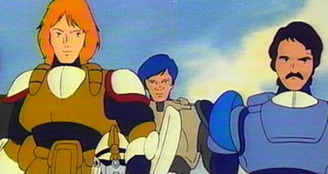 The Robotech Masters |
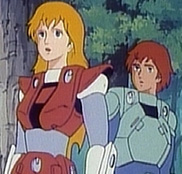 The New Generation |
 |
 |
See Flags and Emblems.
There are two discrepancies regarding Rolf Emerson. The first is that he acts as an operational commander though his appointment title is 'Chief of Staff'. So chief of staff in this context means head of the headquarters staff of an operational commander. Perhaps he is acting on a commander's behalf or is an acting commander by virtue of being the most senior member of the command present. It is Emerson who decides that Dana Sterling should be promoted to the rank of first lieutenant (39), and the officer conducting the promotion ceremony says the 'commander of the army of the Southern Cross' made the promotion. It may be that the officer conducting the ceremony is referring to Emerson, but it may be that Emerson merely recommended the promotion to someone else.
The second arises from a scene in which an officer in an operations centre says, 'Ensign, get me Brigadier-General Emerson'. If it is – as it is obviously intended to be – a reference to Rolf Emerson it would imply that his command consists of no more than a few thousand people, which is inconsistent with the evidence of him being a more senior officer. It's possible to circumvent this discrepancy by supposing that the fact that the modifier 'brigadier' is used indicates that there is more than one general officer with the surname Emerson relevant to the duties of the officer in the operations centre. If not, why bother specifying the full rank? Suppose that Rolf Emerson holds a higher rank and when the officer in the operations centre refers to 'Brigadier-General Emerson,' he is referring to an officer lower in his chain of command than Rolf Emerson. Not an elegant or likeable solution, but it works.
Global Military Police is the name of the police corps/branch of one or more of the UEF's services. GMP organisations are dispersed among numerous commands, including formations within the Southern Cross. That the term is not mentioned throughout the entire TV series is not a reason to conclude that the GMP had different names at different times.
A headquarters (HQ) is the establishment at which the head of a military organisation is located. It may also refer to the HQ staff organisation. The HQ staff of an organisation headed by someone who holds a general rank may be called a general staff (45) (a term used most conspicuously in the real world when used in connection with the heads of certain armies and their staffs).
There are a number of vague references to the higher levels of the defence organisation:
- high command (39, 40, 46, 50, 58);
- Earth command (51);
- united Earth command (47, 48);
- Earth defence command (47);
- supreme command of the united Earth government (49);
- supreme command (47, 49, 50).
'High command' is a general term for the highest levels in the chain of command of a defence organisation, which, in Robotech, would include the minister, the Joint Chiefs of Staff and the highest operational commanders. 'United Earth command', 'Earth defence command' and similar terms can be taken as meaning much the same thing. Depending on the context 'supreme command' could mean supreme command of the UEF, which means the minister (subject to higher authorities), or the supreme commander of an organisation within the UEF.
It is often the case that a person may hold more than one appointment at the same time. For example, the five distinct appointments of Commander US Marine Corps Forces Pacific, Commander US Marine Corps Forces Korea, Commander US Marines Central Command, Commanding General Fleet Marine Forces Pacific and Commander Marine Corps Bases Pacific are all held by one person. Naval task group, unit and element commanders are usually also the commanding officers of individual ships. In Robotech Captain Gloval appears to be simultaneously the commanding officer of SDF-1 and the overall commander of the force comprising SDF-1 and her associated aviation and other forces.
There are a number of instances in the dialogue where characters are referred to as troopers (38, 39, 42, 57). Although trooper traditionally refers to Armoured Corps privates, clearly it has a broader definition in Robotech.
If all Earth forces depicted in all three parts of the TV series had exactly the same style of uniform, no one would think that they weren't part of the same organisation. Uniform differences of the kind in Robotech are a weak basis for the proposition that the UEG has several military organisations that are unconnected, especially as it is such an outlandish idea. UEF dress uniforms of the TMS era and the post-TMS era are somewhat different, but this isn't a reason to conclude that the TMS era and post-TMS era UEF are not one and the same. Military services in the real world have many different uniforms, which change from time to time without coinciding with the creation or abolition of organisations. The US Army is (at the time of writing) phasing out its green dress uniform, but it won't have ceased to be the US Army at the end of that process.
Any military service will have a number of different uniforms, which generally conform to the following types: ceremonial, service (i.e. general purpose dress uniform), mess (i.e. evening wear), general purpose working/combat, and special-purpose (flight suits, tank suits, medical clothing, etc.) Each individual uniform may include several variants (e.g. certain garments may be worn at individual discretion).
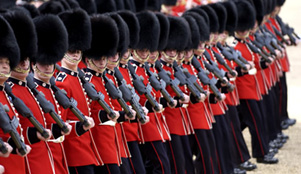 |
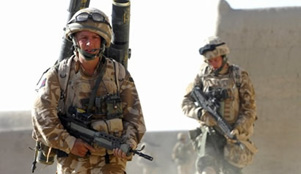 |
Different parts of the one service may have very different equivalent uniforms at the same time.
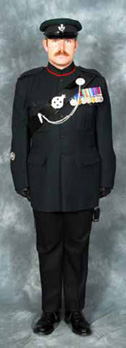 |
 |
In fact the uniforms of the TMS and post-TMS eras in Robotech are far more similar than different. A number of characteristics are common, including the style of shoulder covering (reminiscent of kataginu), high collars, and bright and varied colour schemes. (Military clothing in TNG, including Colonel Wolfe's ceremonial uniform seen in episode 68, should not be considered as being separate from other post-TMS military clothing.) Try to think of real-world military uniforms that look more like the TMS era UEF uniforms than the post-TMS era UEF uniforms! Rather than the differences between TMS era and post-TMS era uniforms being seen as indicative of organisational difference, their similarity may be seen as indicative of an absence of such a difference.
As in the real world, uniforms may vary considerably according to service, branch, unit, rank, climate, sex, function, location, formality, some items of clothing can be worn at individual discretion, and items can be introduced and abolished from time to time.
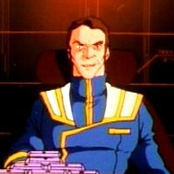 The Macross Saga |
 The Robotech Masters |
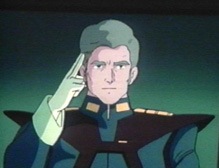 The Robotech Masters |
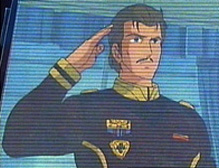 The New Generation |
Two decades after Robotech's creation the creators of TSC (seemingly oblivious of Robotech's already considerable problems regarding cohesion) inexplicably made the stupid decision to depict UEF uniforms in a way that is very inconsistent with their depiction in the TV series. We can ignore certain elements on the basis that they are outright contradictions. Because of being away from Earth for such a long time, the Expeditionary Force would not necessarily keep up with uniform changes imposed on Earth-based forces anyway. The Expeditionary Force would very likely have its own clothing manufacturing facilities and it's plausible that exigencies of service may eventually result in a noticeable lack of adherence to regulations enforced on Earth.
Real-world examples of typical armed forces uniforms:
- Royal Australian Navy (headwear not shown);
- Australian Army;
- Spanish Navy;
- Royal Air Force (male uniforms) (1.5M PDF file).
| OTHER ARTICLES | vofr.tripod.com Copyright © 1998 – 2015 |